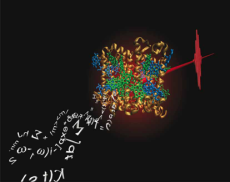Artificial Photosynthesis I - Design Principles for Light Harvesting
Key Challenges: Researchers measure a two-dimensional (2D) Fourier transform electronic spectrum from real photosynthetic proteins and use statistical mechanics simulation at NERSC to calculate the non-linear optical response in the spectrum. This is a computationally-demanding chore because the spectrum contains an average over all contributions from an energetically disordered ensemble of energy states, requiring large numbers (500-5000) of independent calculations. The quantum dynamics of excitation energy and charge transfer in the photosynthetic pigment-protein complexes are also computed, as is simulation of the photosynthetic light reactions themselves to understand a plant's feedback response to fluctuations in light intensity.
Why it Matters: The chemical physics details of the initial stages of photosynthesis, the process in which photosynthetic pigment-protein complexes convert the energy of sunlight into a chemical form, are not yet fully elucidated. Understanding the mechanism of excitation energy conversion within actual photosynthetic complexes can provide valuable insights that might be applied to improve artificial solar energy harvesting devices. This research examines quantum dynamics to explain why naturally occurring systems carry out photosynthesis so efficiently and the design rules that govern the structure and dynamical processes of excitation energy transfer.
Accomplishments: Fleming's group has simulated the electronic energy transfer quantum dynamics in the major light harvesting complex of photosystem II (LHCII). The results demonstrate robust quantum entanglement under physiological conditions for the case of a single elementary excitation. The simulations helped understand the impact of the protein upon quantum delocalization and quantum entanglement. Recent work has demonstrated the importance of quantum coherence - that electronic excitations of pigments travel though photosynthetic proteins as quantum mechanical wave packets keeping their phase coherence, rather than by incoherent diffusive motion as has usually been assumed.
Principal Investigator: Graham Fleming (UC Berkeley)
More information: See Phys. Chem. Chem. Phys., 2010, 12, 7319–7337 (journal issue cover story) and references therein or the Fleming group's web site.








